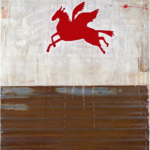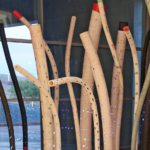The Art of Ubiquity

Writer Amanda Christmann
Photographer Scott Baxter
[dropcap]O[/dropcap]n a breezy but sunny Arizona winter day, John Randall Nelson answered his door wearing comfortable jeans and a paint-spattered denim jacket. A gray beanie, crocheted from yarn, hugs the crown of his head. He’s a tough-looking guy, tall and sturdy with a strong Romanesque nose, but he’s quick to grin with a smile that emanates from the inside.
Nelson’s warm greeting despite his seemingly formidable appearance is entirely apropos; after all, nothing Nelson creates is exactly as it appears upon first impression.
Like his use of recycled large format printer paper rolls, transformed into a sardonic forest of color for an exhibit titled “Phallic Affirmations,” or the visual doublespeak found in ironic works like his “Knowledge” and “Mixed Witness,” archetypes, symbols and typography seem to send contradicting messages in much of what he does.
Everything that Nelson surrounds himself with hints at what lives down the rabbit hole of his mind. Each piece of his work, whether it’s a sculpture, painting or the medium du jour, is as if he has taken traditional American folk art and added a flaming Socratic question mark. It’s fun, it’s cryptic and it’s unavoidably esoteric.
Born in Princeton, Illinois, among Nelson’s most vivid childhood influences were the Catholic Church and parochial school he attended. Symbolism, tropes and narratives of Catholic iconography permeated his brain and raised more questions than they provided answers.
He was also a short drive from Chicago, where artistic expression is ubiquitous, from its sobering Greek and Gothic Revival and Edwardian architecture to colorful, often ironic or lewd graffiti art. All of it fascinated Nelson.
“Part of me always knew I was an artist,” he explains as he sits in a comfortable, time-worn chair in his tidy studio space. “I was really aware of visual design. I was always mesmerized by illustration, even as a kid.
“I grew up in a small town, but I always had an education in art history. Through the Catholic experience, I always had an appreciation for the idea that a painting could be a didactic tool to educate you on history and the teachings of the Church. Chicago was nearby, so my sister would take us to shows and museums. I was always amazed that anybody could make the kind of pop art they were making in the 60s and 70s. I knew I was in my element.”
Those influences became part of Nelson’s style—or more precisely, his language. Along the way, he began to form his own verbiage in urban-neo-folkism, striking up conversations through use of visual vocabulary taken from American folk art and the Pattern and Decoration movement of the 1970s and ’80s. As he creates, he delights in the ambiguity of it all.
“My work is kind of like a big Rorschach test,” he says with a laugh. “It’s obscure enough that there’s no specific story; it leaves people with more of an intuitive story based on their own experiences and personal psychology.”
Despite his focus on archetypes, Nelson is, in ways, far from the stereotypical artist. He is not the eccentric artist furiously creating at the expense of sleep, sanity and relationships. In fact, he is surprisingly centered. His wife, Gail, has moored him since college. He credits her for much of his success. Together, they built his increasingly renowned career in art and raised two successful daughters.
Like most artists, Nelson began his career in the corporate world, illustrating for publications like The New York Times, Washington Times, Washington Post and Rolling Stones. “I figured out early on that I wasn’t cut out for commercial art,” he explains. “I wanted more freedom. I wanted my work to become my work.”
Wanting to pursue his master’s in fine art, Nelson and his wife settled on Arizona for both the art program at ASU and for the warmth of the desert sun. Art shows became a bigger part of his schedule, and his work gained acclaim.
In recent years, his popularity has built momentum. He has actively shown in solo and collective exhibits in Los Angeles, Seattle, San Francisco, Dallas, Santa Fe and Phoenix, among other locales.
Nelson is also shaping the face of the Phoenix metro area. He has also done public art installations at Scottsdale Center for the Arts, the University of Arizona, Mitchell Park, Sky Harbor Airport, Marcos de Niza High School, Wells Fargo office complex, the Mill Avenue streetscape, Tempe City Hall and more.
Private and public collectors have taken a keen interest in his work. Dozens of collectors, including famous folks like John Legend and Danny Elfman and entities like the City of Phoenix, Apple, Nordstrom Inc., Wells Fargo, United States Post Office, Intel, Perrier, Target, Disney and many more have commissioned his work.
Behind each is a story, but Nelson often remains tight-lipped about his own interpretation—except for one exhibition.
In 2014, Nelson created a large-scale installation of shapes and patterns using polka dots as whimsical focal points and background elements. In most pieces, he incorporated typographical “affirmations” representative of the pursuit of positive thinking that seemed to envelop the world at the time.
In choosing the title, he decided to give a nod to Holly Solomon, a New York art dealer who influenced his style and spearhead the Pattern and Decoration movement. He called it “Polka Dots for Holly Solomon.”
Like so many other projects, unintentional irony set in. Nelson realized that there was another infamous Holly Solomon living in Phoenix, famous because she ran her husband over with an SUV during an argument over the fact that he voted for Barack Obama in 2012.
To Nelson, the title became even more fitting.
Today, Nelson is adjunct professor at Phoenix College and Arizona State University and he continues to show his work in a variety of public and private venues. This month, he will be featured at Gebert Contemporary Art on Main Street in Scottsdale.
Mostly, though, he continues to be driven by an urgent need to create that is much bigger than him.
“I think I’m obsessed with [art],” he says with a matter-of-factness that belies the significance of his statement. “I think you have to be. I don’t think that people have a choice whether they are or are not an artist. I don’t think, if you’re truly an artist, that you can quit making art.”
John Randall Nelson Exhibition
Gebert Contemporary
January 11 – February 11
7160 Main St., Scottsdale
480-429-0711




